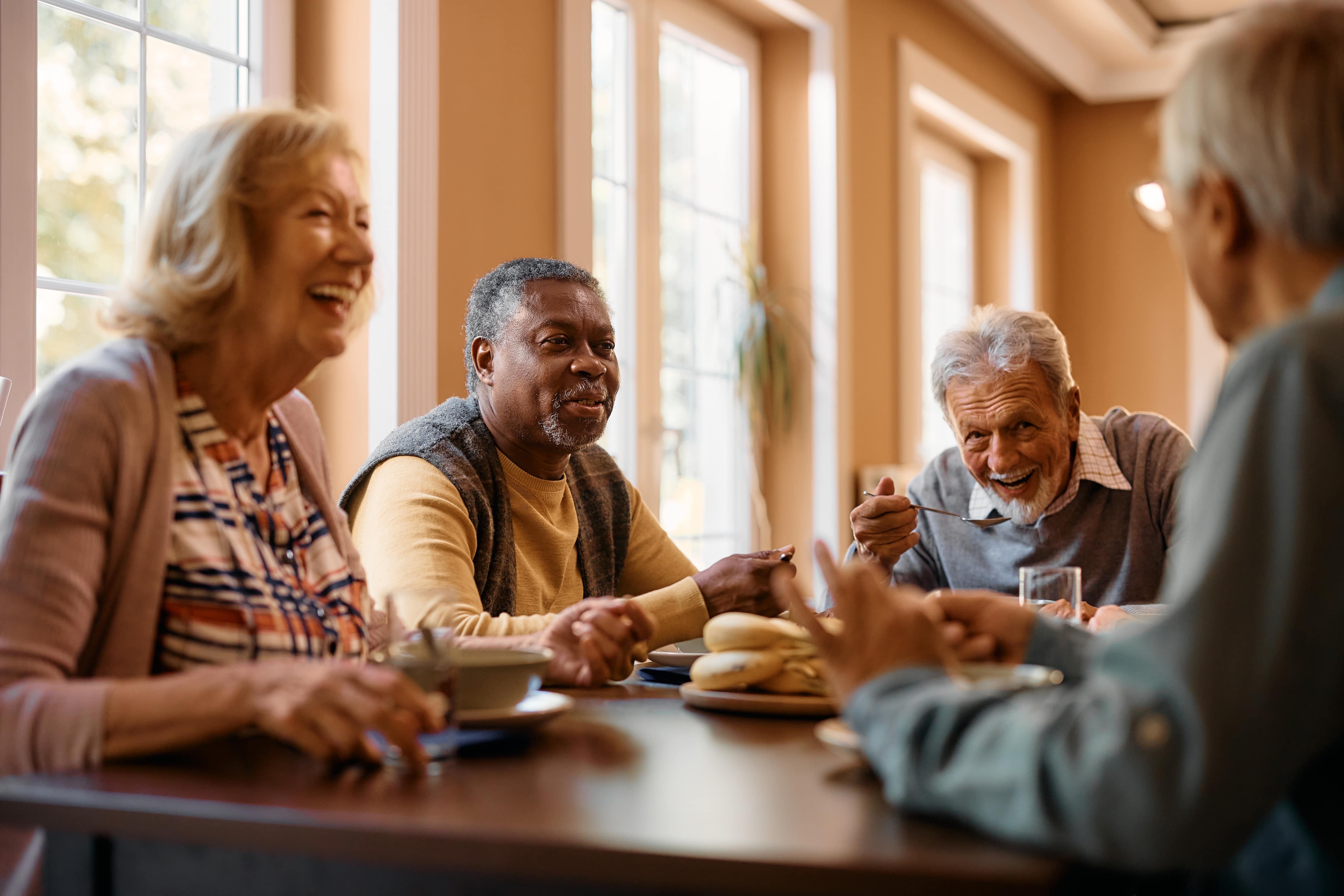Asset Publisher
Barriers to Older Adults Remaining Social: Lessons Learned From the Pandemic
By Abbey Carney | 06/15/2023

Four older adults socializing over breakfast at a restaurant
Social isolation has always been a common issue for older adults, but became even more recognizable during the COVID-19 pandemic. Over the past few years, we have seen the negative effects of loved ones being kept alone. According to the Centers for Disease Control and Prevention, extended periods of social isolation have resulted in an uptick in hospitalization of older adults due to health concerns, and an increase in depression and anxiety disorders across all ages, especially in older adults. Pandemic restrictions contributed to stress level hitting an all-time high, while at the same time lowering access to the social supports older adults and caregivers rely on for respite and building social connections.
The pandemic made many people aware of these challenges, but both before and after, older adults have struggled with access to transportation, knowledge of technology, smaller support systems and limited opportunities to socialize. These barriers can be reduced with help from family and friends, services for older adults and the community, as well as the lessons we’ve all learned from finding solutions to respond to the pandemic.
1. Transportation
Limited transportation for older adults can keep your loved one isolated physically, whether they no longer own a car, can no longer drive safely or prefer to take other means of transportation. The pandemic showed us how already limited options for travel can be limited further due to closures and restrictions.
If your loved one lacks opportunities to get out of the house, consider blocking off one evening per week to take your loved one on an outing: to the grocery store, to a park or over to your house for dinner. By designating one day per week, you give your older loved one something to look forward to each week.
If you cannot commit to once a week, reach out to your community to identify any transportation services dedicated to transporting older adults at a low cost to help get them out of the house and to their favorite activities safely.
2. Knowledge of technology
Younger generations are well versed in the latest technological advances that help us stay connected when we are not able to gather physically – Facebook, Zoom, Facetime, texting, etc. Limited access and knowledge of technology, also known as the “Digital Divide,” is a barrier older adults faced during the pandemic, and continue to face as technology continues to become the norm in more and more aspects of life.
To engage your loved one in technology, consider sitting down with them and teaching simple texting functions on their phone, or showing them how to answer a Facetime call when their grandchild wants to video chat. You can also connect them with technology that is user-friendly for older adults, such as the Grandpad tablet or Jitterbug phone.
Another resource for technology education you may not be aware of is your local library! Most libraries have technology courses, access to computers and hired technology teachers that can assist your older loved one in connecting with family and friends. Many senior centers also offer computer lessons, and Benjamin Rose Institute on Aging has the Connecting Our Seniors to Technology (COST) program, which further assists older adults by providing them with laptops and internet access when they complete the program.
3. Smaller support systems
It’s not uncommon for a loved one’s support system to get smaller as they age. Older adults may retire from careers where they spent time with friends and colleagues, they may move homes to be closer to family or to transition to a more age friendly location, and they may have friends who have passed away. In situations like the pandemic, they can also be suddenly cut off from people they rely on, such as family and service providers.
When these support systems get smaller, it is important for older adults to maintain the relationships they have while finding ways to make new ones. Older adults should be encouraged to stay connected to friends in whatever way they can, such as by making phone calls, writing letters or arranging get-togethers. New friends can be made through visiting senior centers or other community programs for older adults, or by participating in companionship programs. If your loved one is missing someone who passed away, look at old photos together and reminisce about happy memories they made in previous years.
Isolation has proven to have detrimental effects to the health of older adults according to the CDC, including increased risk of heart disease, stroke, dementia, depression, and anxiety. Socialization needs to be a priority and should be treated with the same care as other daily living needs. The creative ways to overcome these barriers may change, but constant innovation and adaptiveness to these changes can allow you to better serve your community and older loved ones in ways you have not previously.
Related Assets
Suggested Reads
Connecting Our Seniors to Technology
Our free computer classes can help older adults learn how to use the internet safely and confidently with the support of both technological and financial coaching.
Read MoreWays to Manage Social Isolation
The negative impact and detrimental effects of social isolation remain an important topic. The AARP Public Policy Institute’s 2018 study “highlighted social isolation as the new silent killer – a major risk factor for a host of conditions, including heart dise...
Rose Centers for Aging Well
Rose Centers for Aging Well, a subsidiary of Benjamin Rose Institute on Aging, exists to promote successful aging for Northeast Ohio’s adults by offering opportunities, programs and services that foster choice and independence.
Read MoreSenior Companion
Benjamin Rose's Senior Companion Program connects older adults in the Greater Cleveland area with trained peer volunteers who offer help and companionship.
